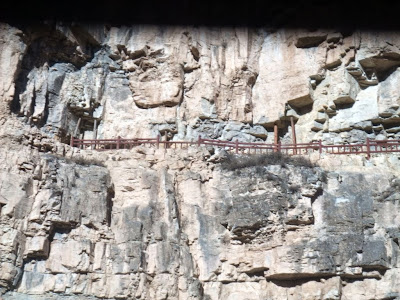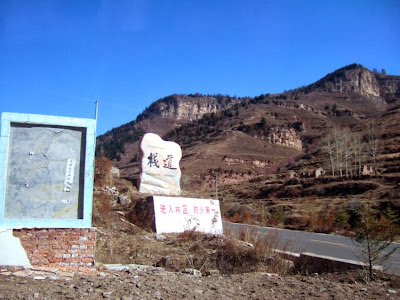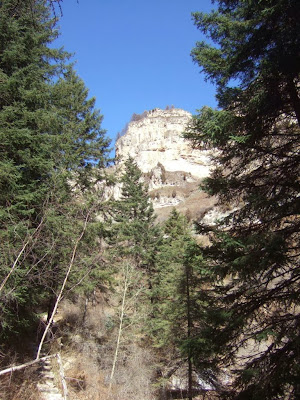
The excavation of ancient passage way (古栈道) along the sheer precipices was an incredible and miraculous task in China's transportation history. The cliff passage ways were the connected bridges or walking rails built and supported by the chiseled holes at mountain rocks. Along the river side of Huanghe (黄河), stretching from west to east, there were 40 remains of cliff passage ways to a total length of 5000 meter were found. For 400 over years in ancient China, commencing from 221 BC when Qinshi-Huang (秦始皇) united China and set his capital in Xi-an (西安), until the end of Han Dynasty (206 BC - 220 AD), Huanghe was the main goods transporting channel in China. At that period, water way was comparatively convenient compared to the toughness in traveling by undeveloped roads in the limited vehicles and unequipped carriages. But the costing of water communication was very high as the water and current at mid stream of Huanghe was very swift and strong, which caused difficulties for the boats to sail especially when it was against the flow. Sheer peaks, rocky cliffs and mountain ridges along Huanghe also were the sailing obstacles along the route. In order to ensure the smoothness in the flow of traffic, government of subsequent dynasties were putting great effort to overcome the problem. As a result, cliff passage way in line with Huanghe especially at the straits of Sanmen-xia (三门峡) were excavated and formed. These winding passages that built above river 2-10 meter high, were the alternative way for boat-trackers to move on when the flow of Huanghe River was too swift with strong current. They towed and pulled the boats by their body with a wooden plank tied on their chests that linked to the tracking line of the boats, and continued the journey on land. Cliff passage ways marked the transportation history in China and also reflected a tough life of their ancient boat-trackers.



The 42km long cliff passage way at Qingzhen-shan (清真山) in Dongzhai hundred meters above ground level at the rocky cliff, was believed to be built by the religious devotees to connect temples that had widely scattered at the sheer peaks or slopes of Guancen-shan mountain ranges.


It was said that the cliff passage ways at Dongzhai was first built in Tang Dynasty during Zhenyuan period (贞元年 785-805).



The 42 km cliff passage ways were inside these steep precipices and sheer cliffs


About 2km of the cliff passage way was recently restored and opened to public. To visit and experience it, visitors have to go through numerous staircases to the arch gate and climb up from a long rocky narrow path behind it.



The steep rocky precipice where 2km of cliff passage was restored, is located in a canyon facing thick wood in front.


We can reach the temples at the cliff by walking through the cliff passage way.


A unique landscape



The little natural rocky path is one of the way that leads to the foot of Cliff Passage Way.



We decided to stop by a stream side after finished climbing the 1000 over meters long rocky narrow path, as we were told that the 208 stone steps ahead of us, that lead directly to the foot of the cliff passage way were covered with snow and ice. It was not too safe to move on any further.



We failed to reach the final destination and missed the chance to experience the excitement of crossing the ancient cliff passage. But we enjoyed the serene and unique environment at this part of the world.



Admire the sheer precipices in the surroundings.




Besides the Cliff Passage Way, Hanging Village, Suspended Coffins, Hanging Temples are also one of the four awesome hanging sights in Dongzhai. Many ancient temples at site were built against the cliff in line with the landscape.



Most temples were accessible and could be connected by cliff passage ways.


Temples were built more than 100 meters above ground level mostly were to avoid water flooding.


The construction style and building method of Hanging Temples at Dongzhai was exactly like the Hanging Monastery in Hunyuan at Datong but it was much smaller in scheme.


A splendid sight, indeed!


No comments:
Post a Comment